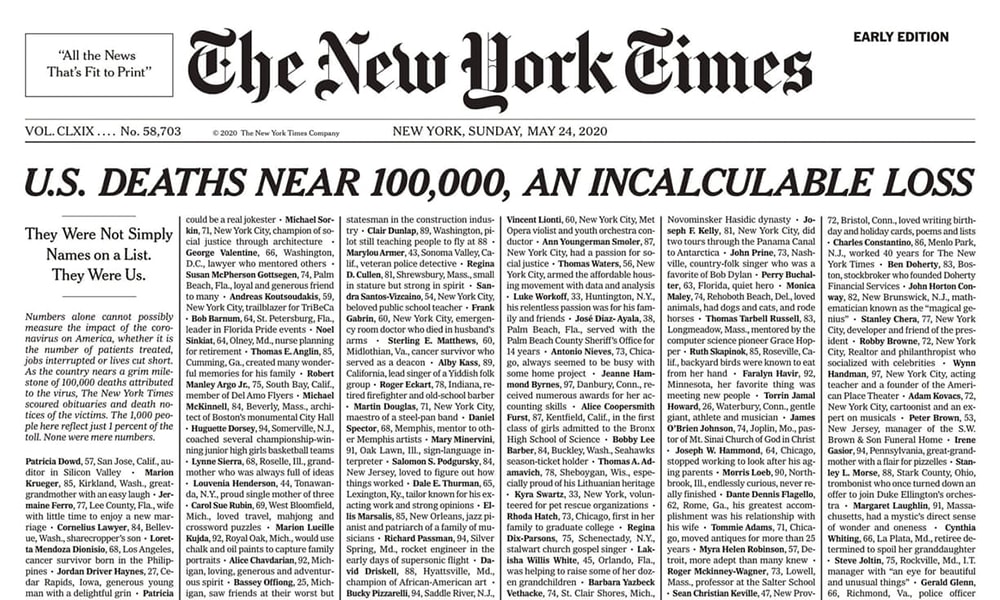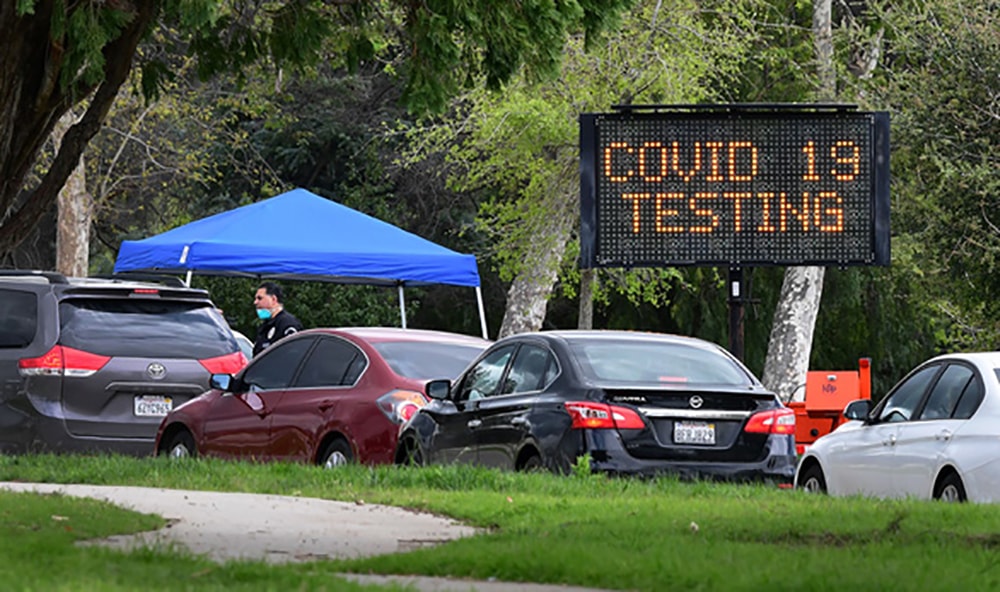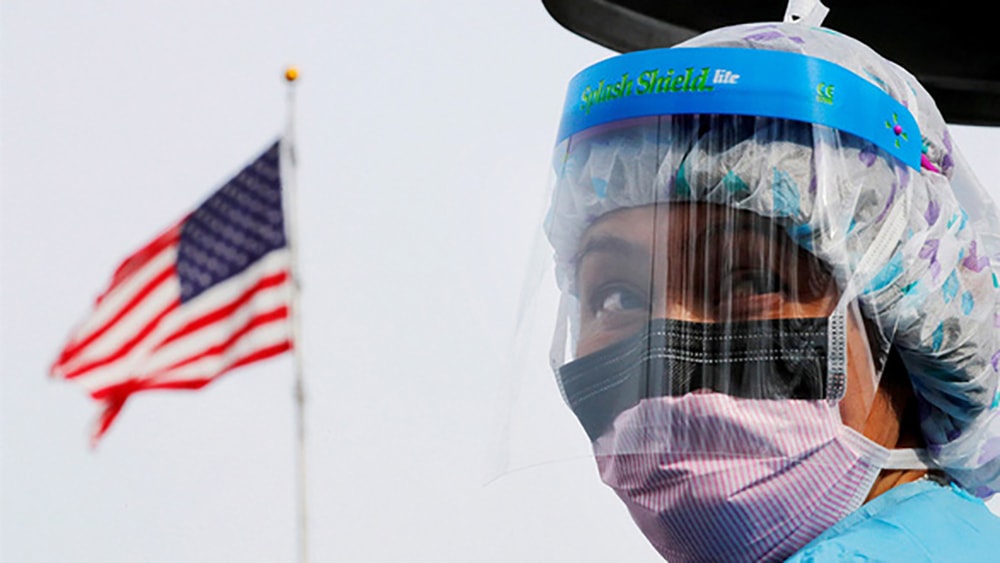The world last week: Alarm bells
(Baonghean.vn) - For the first time in history, the New York Times devoted the entire front page of an issue to commemorate the victims who died from Covid-19, showing the severity of the pandemic for the US in particular and the world in general. Meanwhile, in South Korea, the country has recorded many new infections in a number of outbreak clusters, forcing authorities to re-impose a series of social distancing measures. These are notable contents of the past week.
SPECIAL OBITUARY
Instead of the eye-catching graphic articles that usually appear on the front page of The New York Times (NYT), the May 24 issue was filled with a long, solemn, three-page list of what is called an obituary of those who have died from the Covid-19 pandemic across the country.
 |
| The New York Times devoted a full-page obituary to remember Covid-19 victims. Photo: The Guardian |
The influential US newspaper emphasized in its headline: “The death toll in the US is nearing 100,000, an unspeakable loss.” And the way the newspaper detailed the deaths made the whole community think. In the short introduction at the beginning of the article, it said: “The 1,000 people here represent only 1%. They are not just names on a list. They are us. Numbers alone cannot measure the impact of Covid-19 on the US, whether it is the number of patients treated, the number of jobs affected or the lives taken.”
The NYT said they had previously spent time researching how to depress the 100,000 death toll. They collected names from 1,000 obituaries and death notices in American newspapers to emphasize the number of casualties in the pandemic. According to research by Johns Hopkins University, the number of deaths from the epidemic in the US is more than 97,000 people, the highest in the world.
In an article for Times Insider, Simone Landon, assistant graphics editor at the NYT, explained that this was a way to personalize the tragedy when readers and data developers were tired of constant updates about the pandemic. Landon led a research team that searched hundreds of American newspapers for obituaries that listed Covid-19 as the cause of death, then took the name and the most important personal details that described the uniqueness of the deceased. For example: “Alan Lund, 81, Washington, conductor with “the most amazing ear.”
 |
| The US is currently the world's largest epidemic area with more than 100,000 deaths. Photo: TIME |
Landon said that simply putting 100,000 dots or embeds on a page doesn’t really tell the reader much about the people who died, the lives they lived, and the meaning of their lives. So he came up with the idea of compiling obituaries and death notices of Covid-19 victims from newspapers large and small across the country.
The design was presented early, but presenting a front page of a newspaper without an image is “certainly a first in the modern century and since the paper was published in 1851,” said Tom Bodkin, NYT's creative director.
There are celebrities who have appeared in special obituaries in the Times. For example, “Joe Diffie,” 62, of Nashville, the Grammy-winning music star, or “Lila A. Fenwick,” 87, of New York, the first black woman to graduate from Harvard Law School. But that is not a privilege reserved for a small, socially prominent group. Hundreds of other ordinary people have been introduced in the same formal way in the Times. There is “Myles Coker,” 69, of New York, who was freed from a life in prison; there is “Ruth Skapinok,” 85, of Roseville, who hands out food to backyard birds; there is “Jordan Driver Haynes,” 27, of Cedar Rapids, the kind young man with a charming smile…
 |
| A nurse at a testing station in Seattle, Washington state, USA. Photo: Reuters |
The NYT shared its front page on Twitter at the same time and within a few hours received 61,000 retweets and more than 116,000 likes. Many comments under the post expressed grief and mourning: “1,000 names, 1,000 stories”, “Shocked and sad”. And an NYT editor shared: “100 years from now, when we look back, the next generation will understand what we are going through”. May 27 marked the number of deaths from the epidemic in the US surpassing 100,000 people. The number shows the severity of Covid-19.
BE HIGHLY VIGILANT
South Korea has eased social distancing measures and shifted to “daily life prevention” starting May 6. However, soon after, the country’s health authorities discovered a number of outbreaks with a very high risk of infection in the capital Seoul and surrounding areas, which account for nearly half of the country’s population. Recently, on May 28, the Korea Centers for Disease Control and Prevention (KCDC) said that the country recorded 79 more Covid-19 infections, the highest increase since April 5.
The Northeast Asian country's new surge in cases is due to cluster outbreaks in Seoul's Itaewon district and a warehouse run by e-commerce company Coupang in Bucheon, Gyeonggi Province, west of Seoul. 69 cases have now been reported at the warehouse. All staff at the facility who had contact with the patient have been quarantined and the facility has been shut down.
 |
| Coupang's warehouse in Bucheon, South Korea, in this photo taken on May 27. Photo: Reuters |
South Korea will reimpose a series of social distancing measures to prevent a new wave of Covid-19 infections, Health Minister Park Neung-hoo said. All museums, parks and art galleries in the Seoul metropolitan area will be closed again for two weeks from May 29 to June 14, while companies will be asked to re-introduce flexible working methods.
Before the incident, South Korea was praised by the world as a model for effective epidemic control without applying strict lockdown measures. Thanks to active testing, application of technology in tracing infected cases, people's cooperation and compliance with community distancing, South Korea quickly flattened the "curve" on the chart. This positive development prompted the South Korean government to loosen restrictions, switching to a strategy of "distancing in daily life", aiming at the goal of normalizing society, especially reopening the economy.
But the outbreak of a new wave of the disease in South Korea, Time columnist Amy Gunia warns, shows that all countries, even those that have controlled the pandemic, must remain vigilant. The city of Wuhan (China), where the pandemic began, decided to test all 14 million people after recording a new case in the same residential area.
 |
| South Korea eased social distancing measures starting May 6. Photo taken at a subway station in Seoul on May 18. Photo: Bloomberg |
Despite the difficulties ahead, experts still expressed confidence in South Korea's ability to control the epidemic with the system that helped them succeed. Son Young-rae, a senior epidemiologist strategist for the South Korean government, assessed: "A second wave of the epidemic is inevitable. However, South Korea is operating a continuous surveillance and screening system throughout society, so it can prevent the epidemic from exploding as quickly as before."

